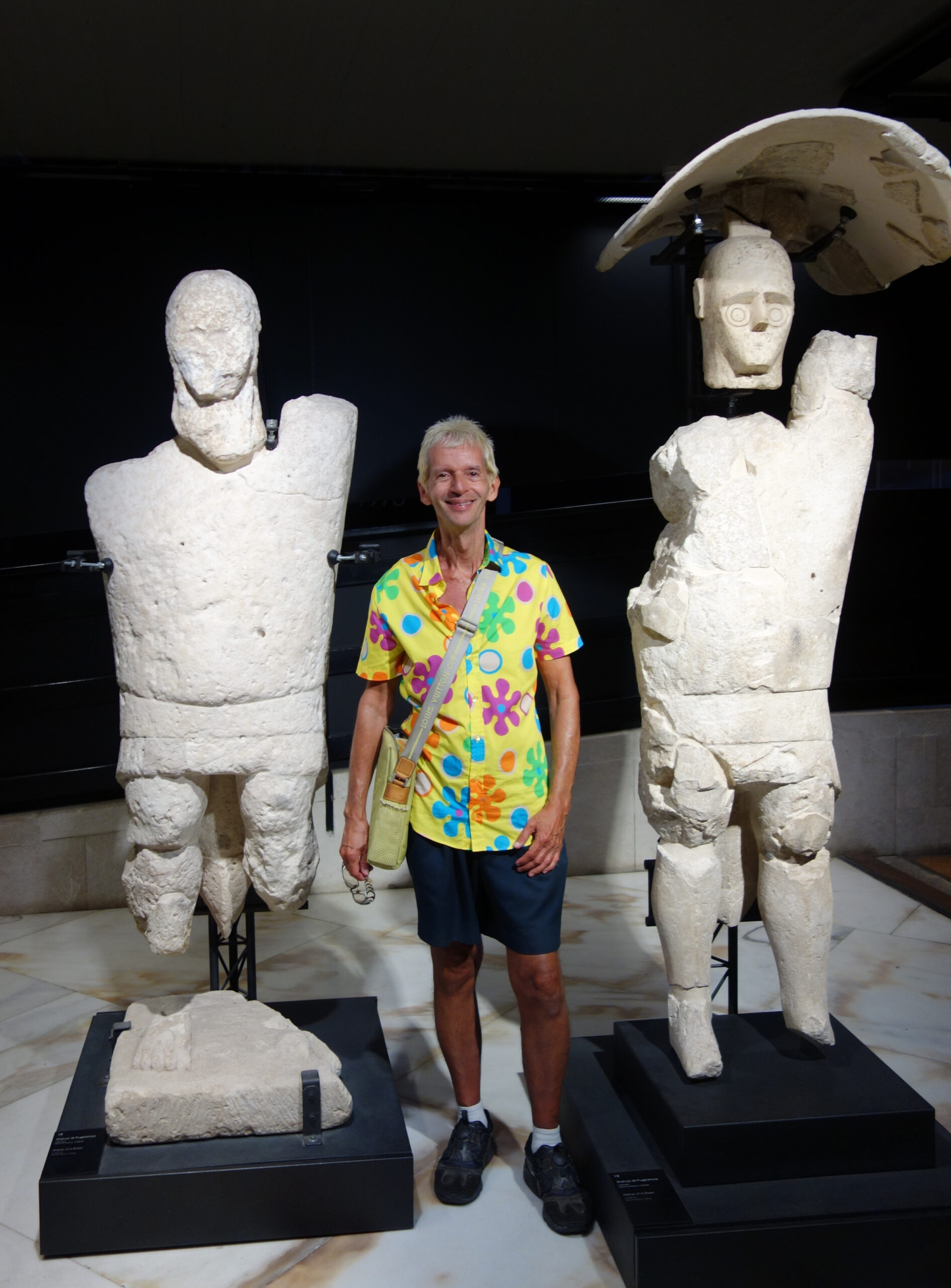Standing beside the giant statues of Sardinia, some 7 feet tall, is an awe-inspiring experience. The photo shows the author in Cagliari, the capital of Sardinia. I was in the National Archeological Museum, home to the majority of these incredible discoveries. They date to the period 1150-900 BCE, making them 3,000 years old.
Originally uncovered over a period of years, these statues were in more than 5,000 fragments. To date, 44 of these limestone sculptures have been found, but their history is lost. The people who created them left no written record, so the best modern archaeologists can do is speculate as to their meaning and purpose.
One of the authors in the book encapsulates our best assessment of them: “These grandiose sculptures date back to the Iron Age, glorify military and religious values, and claim the inheritance, lineage, and hegemonic position of the ancestor heroes who built the nuraghe.” He is referring here to the large stone structures that dot the landscape of Sardinia. The most famous of these nuraghe is Su Nuraxi, 60km north of Cagliari. An exploration of this is well worth the visit, even if you must hire a driver to take you there (as I did). Su Nuraxi, which sits atop a series of terraces, and the other nuraghe were old when the Giant statues were built. They date to the Middle Bronze Age (1500-1300 BCE), so roughly 200 years separates the youngest nuraghe and the oldest Giants. Why the nuraghe were abandoned is also unknown, but it seems clear the Giants harkened back to the ‘ancestor heroes’ who built them. When the Romans invaded Sardinia many centuries later, they used the existing nuraghe as they could not build anything superior.
This is the first book in English on the Giant statues; the background of its two editors is printed below. The complete modern unearthing of the statues is thoroughly covered. It all started 50 years ago, in 1974, “when a farmer was ploughing the land. He found a large head and other stone sculptural fragments.” Immediately recovered by archaeologists were four stone torsos, a head, and two capitals shaped as a nuraghe terrace. The first scientific investigation was launched the next year, but after 1979 “research was no longer carried out on the site” on the west coast on Sardinia. From 2007 to 2011 attention was focused on restoration. Excavations resumed in 2014, with the book describing new finds as recent as 2022.
In the photo with this article, one figure, who is unarmed, holds a shield above his head. Close examination of the sculpture reveals dagger wounds on his chest and defensive wounds on his lower limbs. It appears this is a representation of a youth, perhaps 17 years old, being “initiated into adulthood by means of a bloody training school in which the opponent is equipped with a dagger. The youth defends himself with a shield of soft leather.” Eventually these warriors would be armed with a bow, and once attaining full warrior status, a sword.
“The Mont’e Prama statues are not isolated at the site. There are multiple dozens of stone sculptures of nuraghe.” As is clear from a study of the Su Nuraxi site, these “miniature nuraghe took pride of place by being positioned on a pedestal in the centre of the circular room, surrounded by a bench against the wall where elites would have been seated. The importance of the real nuraghe was thus transferred to the miniatures that symbolically bestowed the monuments’ and the occupants’ power and prestige to the new centres of political life.”
The phrase that best sums up the Giant sculptures is, to quote the book, an “extraordinary cultural phenomenon.” This book is a great survey of the subject, and it includes a chapter on the illicit trafficking of Sardinian cultural objects, some of which fetch more than $100,000 at auction. For the latest on the investigation and display of the artifacts, visit the website: www.monteprama.it
The text has one serious typo: the entire phrase”southern extent of the site” is repeated on page 1.
The book has 5 authors; About the Editors:
Barbara Faedda serves at Columbia University as the executive director of the Italian Academy for Advanced Studies, where she conceived the International Observatory for Cultural Heritage, and as an adjunct professor in the Italian Department. In 2019, she was appointed ambassador, permanent observer for the European Public Law Organization to the United Nations. Her books include From Da Ponte to the Casa Italiana: A Brief History of Italian Studies at Columbia University (2017).
Paolo Carta is a professor at the University of Trento, where he teaches history of political thought and political theory and serves as dean of the School of Law. He has taught and lectured at the École Normale Supérieure, Columbia University, University of Oxford, Paris Sorbonne, and many other universities. His books include Lottare per il diritto (2020).
A Lost Mediterranean Culture: The Giant Statues of Sardinia’s Mont’e Prama, is $60 by Columbia University Press.
